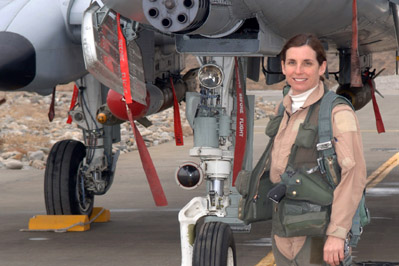- According to role congruity theory, people are evaluated positively when their characteristics are consistent with their social roles.
- A female leader may experience prejudice because her gender is not consistent with the leader position. She "cannot simultaneously act in ways that are consistent with both the female gender role and the leader role because the roles are contradictory."
- "Women tend to be regarded as either warm or competent, but not both."
- Additionally, women who are less stereotypically feminine are generally seen as competent but cold, whereas women who are more stereotypically feminine are typically seen as warm but incompetent.
Being among the nation's most successful female politicians, both Hillary Clinton and Sarah Palin violate traditional gender roles to some extent.
Clinton may experience prejudice because she tends to be evaluated as less stereotypically feminine. The image she projects of herself (characteristics and appearance) is more stereotypically masculine. This makes her fitting with the leader role in the eyes of society but means that she violates the "prescriptive norms of the female role."
To compare, Palin may experience prejudice because she is more stereotypically feminine. Her feminine characteristics are congruent with the female gender role but violate descriptive norms of the leader role.
The media has a large part in creating these perceptions of both women. For Palin, for example, the media will emphasize her previous participation in beauty pageants and her role as a mother -perpetuating the warm but incompetent stereotype. Clinton, instead, is painted as the “iron maiden” -competent but cold.
Much of Martha's campaign literature illustrates her role as "the first female fighter squadron commander, and the first female to fly in combat" and as the one who "overturned a regulation requiring U.S. service women to wear traditional Muslim garb." This places her under the competent but cold stereotype. To balance her reputation as "that fighter pilot chick," Martha needs to show a more warm and caring side. To this end, much of her social media features her love of dogs. Noah, for example, is a pit-bull she rescued in Texas. She raised the money to fly him out to an animal hospital to treat his injuries.
Much of Martha's campaign literature illustrates her role as "the first female fighter squadron commander, and the first female to fly in combat" and as the one who "overturned a regulation requiring U.S. service women to wear traditional Muslim garb." This places her under the competent but cold stereotype. To balance her reputation as "that fighter pilot chick," Martha needs to show a more warm and caring side. To this end, much of her social media features her love of dogs. Noah, for example, is a pit-bull she rescued in Texas. She raised the money to fly him out to an animal hospital to treat his injuries.
The intent is to show the public Martha can be a competent, assertive leader as well as retain the caring warm of the female stereotype.
.png)
.png)
.png)



